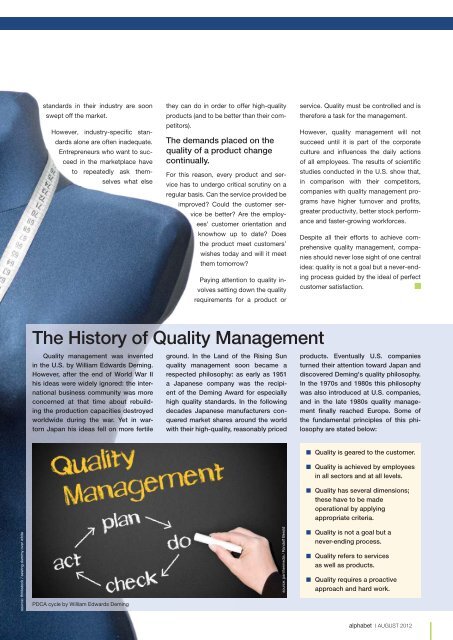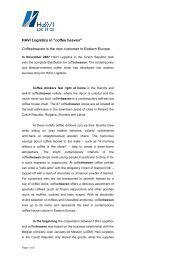3180,3 kB - Media Center - HAVI Logistics
3180,3 kB - Media Center - HAVI Logistics
3180,3 kB - Media Center - HAVI Logistics
Create successful ePaper yourself
Turn your PDF publications into a flip-book with our unique Google optimized e-Paper software.
source: thinkstock / sewing dummy over white<br />
standards in their industry are soon<br />
swept off the market.<br />
However, industry-specifi c standards<br />
alone are often inadequate.<br />
Entrepreneurs who want to succeed<br />
in the marketplace have<br />
to repeatedly ask themselves<br />
what else<br />
they can do in order to offer high-quality<br />
products (and to be better than their competitors).<br />
For this reason, every product and service<br />
has to undergo critical scrutiny on a<br />
regular basis. Can the service provided be<br />
improved? Could the customer service<br />
be better? Are the employees’<br />
customer orientation and<br />
knowhow up to date? Does<br />
the product meet customers’<br />
wishes today and will it meet<br />
them tomorrow?<br />
Paying attention to quality involves<br />
setting down the quality<br />
requirements for a product or<br />
The History of Quality Management<br />
Quality management was invented<br />
in the U.S. by William Edwards Deming.<br />
However, after the end of World War II<br />
his ideas were widely ignored: the international<br />
business community was more<br />
concerned at that time about rebuilding<br />
the production capacities destroyed<br />
worldwide during the war. Yet in wartorn<br />
Japan his ideas fell on more fertile<br />
PDCA cycle by William Edwards Deming<br />
The demands placed on the<br />
quality of a product change<br />
continually.<br />
ground. In the Land of the Rising Sun<br />
quality management soon became a<br />
respected philosophy: as early as 1951<br />
a Japanese company was the recipient<br />
of the Deming Award for especially<br />
high quality standards. In the following<br />
decades Japanese manufacturers conquered<br />
market shares around the world<br />
with their high-quality, reasonably priced<br />
source: panthermedia / Randolf Berold<br />
service. Quality must be controlled and is<br />
therefore a task for the management.<br />
However, quality management will not<br />
succeed until it is part of the corporate<br />
culture and infl uences the daily actions<br />
of all employees. The results of scientifi c<br />
studies conducted in the U.S. show that,<br />
in comparison with their competitors,<br />
companies with quality management programs<br />
have higher turnover and profi ts,<br />
greater productivity, better stock performance<br />
and faster-growing workforces.<br />
Despite all their efforts to achieve comprehensive<br />
quality management, companies<br />
should never lose sight of one central<br />
idea: quality is not a goal but a never-ending<br />
process guided by the ideal of perfect<br />
customer satisfaction.<br />
products. Eventually U.S. companies<br />
turned their attention toward Japan and<br />
discovered Deming's quality philosophy.<br />
In the 1970s and 1980s this philosophy<br />
was also introduced at U.S. companies,<br />
and in the late 1980s quality management<br />
fi nally reached Europe. Some of<br />
the fundamental principles of this philosophy<br />
are stated below:<br />
Quality is geared to the customer.<br />
Quality is achieved by employees<br />
in all sectors and at all levels.<br />
Quality has several dimensions;<br />
these have to be made<br />
operational by applying<br />
appropriate criteria.<br />
Quality is not a goal but a<br />
never-ending process.<br />
Quality refers to services<br />
as well as products.<br />
Quality requires a proactive<br />
approach and hard work.<br />
alphabet I AUGUST 2012<br />
13















